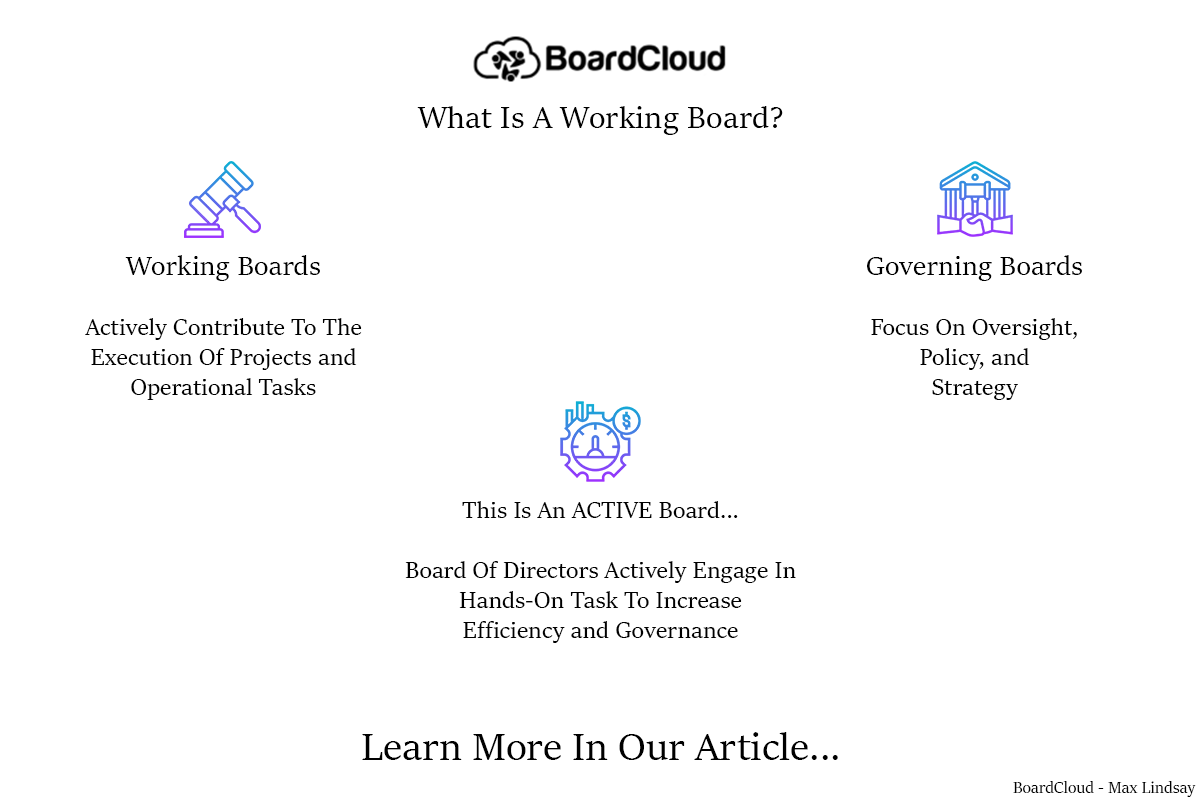What is a Working Board? (Overview, Roles, and Responsibilities)

In the landscape of nonprofit organizations, startups, and small enterprises, a "working board" has become an essential concept. Unlike traditional governing boards that mainly offer oversight and strategic guidance, a working board is deeply involved in the operational aspects of an organization. This article explores what a working board is, its roles, and responsibilities, and what organizations should consider when implementing one.
Defining a Working Board
A working board refers to a board of directors that actively engages in hands-on tasks to support the day-to-day operations of an organization. Members of a working board often take on dual roles, not only providing strategic guidance but also stepping in to perform tasks that, in larger organizations, might be handled by staff. This model is commonly found in smaller or newly established organizations where resources may be limited.
Key Differences Between Working and Governing Boards
- Working Boards actively contribute to the execution of projects and operational tasks, often filling in gaps due to limited staffing.
- Governing Boards typically focus on oversight, policy, and strategy, with minimal involvement in day-to-day functions.
This dual responsibility means working boards play a crucial role in helping organizations thrive in resource-constrained environments, providing a blend of leadership, operational support, and accountability.
The Key Roles and Responsibilities of a Working Board
- Strategic Planning and Direction
- Like all boards, a working board is responsible for shaping the strategic direction of the organization. However, members are more intimately connected to the implementation process and may regularly adjust strategies based on hands-on experience with operations.
- Operational Involvement
- Members of a working board are expected to pitch in with operational tasks. This can range from organizing events and managing fundraising activities to performing administrative work. Working boards may even have members taking on specific roles, such as communications, HR, or program development, especially if the organization lacks a full-time staff for these functions.
- Fundraising and Development
- Many working boards focus heavily on fundraising efforts, which are essential for nonprofit and grassroots organizations. Members often play a lead role in soliciting donations, building community relationships, and overseeing development campaigns.
- Financial Oversight and Budgeting
- A working board is responsible for financial planning, budgeting, and ensuring that resources are managed efficiently. Members may handle financial tasks that would typically fall under a CFO or finance team, such as managing budgets, tracking expenses, and ensuring transparent financial reporting.
- Community Engagement and Advocacy
- Since many working boards are deeply connected to the community they serve, they often take on the role of advocates. Members may actively participate in outreach, fostering partnerships, and representing the organization in community activities to build a solid support network.
- Governance and Compliance
- Working board members also assume responsibilities for governance, ensuring that the organization adheres to its mission and complies with all regulatory requirements. Members should understand and uphold the organization’s bylaws, set ethical standards, and enforce policies that support transparency and accountability. Learn more about Governance and Compliance.
When to Choose a Working Board
Organizations should consider a working board structure if:
- They are in the early stages of growth and cannot yet afford full-time staff.
- They rely heavily on volunteer support for core operations.
- They need board members who can provide hands-on skills and time commitments.
A working board structure often benefits organizations that value agility, creativity, and community-focused decision-making, but it requires careful planning to ensure responsibilities are clear, and workload is manageable.
Transitioning from a Working Board to a Governing Board
As organizations grow, they may decide to transition from a working board to a governing board model. Signs that it’s time for this shift include:
- Increased revenue streams allowing for more staff hires.
- A need for more strategic focus from board members.
- Board members feeling overextended by dual responsibilities.
Transitioning to a governing board allows board members to step back from daily operations and focus on long-term strategies, making it easier to support a growing organization.
Four Common Pitfalls to Avoid
- Overextension – Board members may experience burnout if they take on too many operational responsibilities without adequate support or compensation.
- Role Confusion – Clear role definitions are essential to avoid confusion between board duties and staff functions as the organization grows.
- Lack of Strategic Focus – Operational involvement can sometimes distract from long-term planning, which is vital for organizational growth.
- Resource Dependence – An organization overly reliant on a working board may struggle to sustain operations if board members move on.
How BoardCloud Can Support Working Boards
For working boards, having access to effective board management tools can make a difference in balancing operational and strategic tasks. BoardCloud offers comprehensive board management solutions that streamline workflows, enhance communication, and ensure that essential documents and plans are easily accessible. This can be invaluable for working boards managing both daily activities and long-term goals, helping them work effectively and maintain clarity in their roles.

